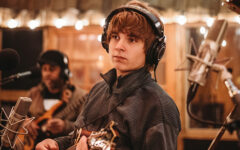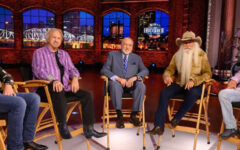The following is a contribution from our newest correspondent, Tom Travis. Tom writes from England where he is prominent in bluegrass journalism and on radio, and also performs with his band, Bluegrass Incident. Here is his critique of a recent BBC television show that involved bluegrass music and the banjo.
 On the whole, I enjoyed the recent BBC TV programme, Play It Again featuring comedian Frank Skinner learning to play bluegrass style banjo. Within the one hour that it lasted, the programme managed to demonstrate some of the best and worst things that befall bluegrass music when it comes into contact with mainstream media.
On the whole, I enjoyed the recent BBC TV programme, Play It Again featuring comedian Frank Skinner learning to play bluegrass style banjo. Within the one hour that it lasted, the programme managed to demonstrate some of the best and worst things that befall bluegrass music when it comes into contact with mainstream media.
On the downside there was the usual ‚Äòhick’ stereotyping of a genre that has been – to quote bluegrass innovator John Duffey ‚Äì "Out of the woods and into town," for the past 40-plus years. Typical of which was the first session filmed at the Winfield Banjo Competition that, maybe because it was in Kansas, featured musicians wearing cowboy outfits. There was an overlong camera shot of some very fancy spurs on the equally fancy cowboy boots of one of the pickers. That was leavened somewhat by the second late-night session demonstrating the magic that occurs when complete strangers get together to play bluegrass at a summer festival.
Then there was the way in which Skinner’s first banjo tutor was treated, in these days of ‚Äòwarts and all,’ brutal, reality television. Veteran banjo picker, Pete Stanley had, I presume, been recommended by the programme’s research team as the suitable person to teach Frank Skinner how to play the 5-string banjo. During the filming of the show, it became apparent to them, for whatever reason, that Stanley wasn’t as suitable as at first thought. Instead of realizing the short comings of its own research people and making the necessary adjustments in a diplomatic way, as good manners would dictate, the production team seized upon the opportunity to have a ritual sacking of Stanley, in the full glare of the camera.
Such treatment proved to me to be not only disrespectful but iconoclastic. I myself have been active in British bluegrass music for around half a century and Pete Stanley was the first person I saw in Britain, playing bluegrass banjo on stage and to a high standard. For that, among other reasons he commands great respect. Yes, I know that during the programme, Stanley had criticized the guitar playing of Skinner’s chum, David Baddiel, after their street session in Germany. But when you are a professional attempting to do a professional job this ‚Äòall pals together’ approach to the music can be irritating and offensive ‚Äì especially to the ears of a professional. Down at the local pub with pickers of mixed ability, is a different matter.
The habit of taking an academic approach to learning to play bluegrass music is comparatively new. When Pete Stanley and I started in the music, it was usual to learn from listening to records and slowing them down to analyse what the particular musician was doing. So when Stanley, having taught Skinner the basic three-finger banjo rolls and chord shapes, handed Skinner the recording of Earl Scruggs playing Foggy Mountain Breakdown, with the recommendation that he listen to it and work out how it is played, (the part of his teaching that brought about his removal from the Skinner tutoring job) Stanley was just doing what was normal for a banjo instructor of his period.
The second tutor, John Dowling, one–time winner of the Winfield Banjo Competition, took the modern approach (for bluegrass teaching) and started by teaching Skinner the importance of scales. Dowling is an interesting and intriguing character in that his playing is probably our first glimpse of bluegrass banjo playing as it might be in the future. He eschews the accepted approach to bluegrass banjo playing, with its up-front, energetic use of widely varying dynamics, the top end of which is very loud and, to some, intrusive. He seems to prefer, maybe because he is British, an understated approach Рhis instrument of choice being an Ozark banjo, without resonator. What he does on it is innovative and always in good taste; different but undeniably attractive.
Having had the pleasure of playing with both Stanley and Dowling, I found both (once I had got over the markedly different style of Dowling) as enjoyable but for different reasons. I just wish that, in the production of the TV programme, Stanley had been afforded the respect and understanding due to a genuine pioneer. But then respect for anyone or anything is a rarity nowadays – especially in the modern world of TV programme makers, who in their desperation to attract viewers seem to indulge in the unworthy.
The idea of entering Skinner, after a few months tuition, in the Winfield Banjo Competition was preposterous and it took a stand-up comedian, used to taking risks on stage, to have the nerve to go through with it ‚Äì even his well-tested nerve gave way under the strain. For all that though, the programme managed to convey Skinner’s genuine love for the banjo and the joy to be had from getting into session with other enthusiasts. It also provided a reminder to those who have enjoyed the warm glow of similar experiences and fueled their joyful anticipation of those yet to come. Ultimately, the programme probably helped the cause of bluegrass music by introducing it to people, previously unaware of the undeniable pleasures that it offers.
Tom Travis
Editor’s note: The Play It Again show featuring Frank Skinner generated a lively discussion on The Banjo Hangout, a web community of banjo players worldwide.







